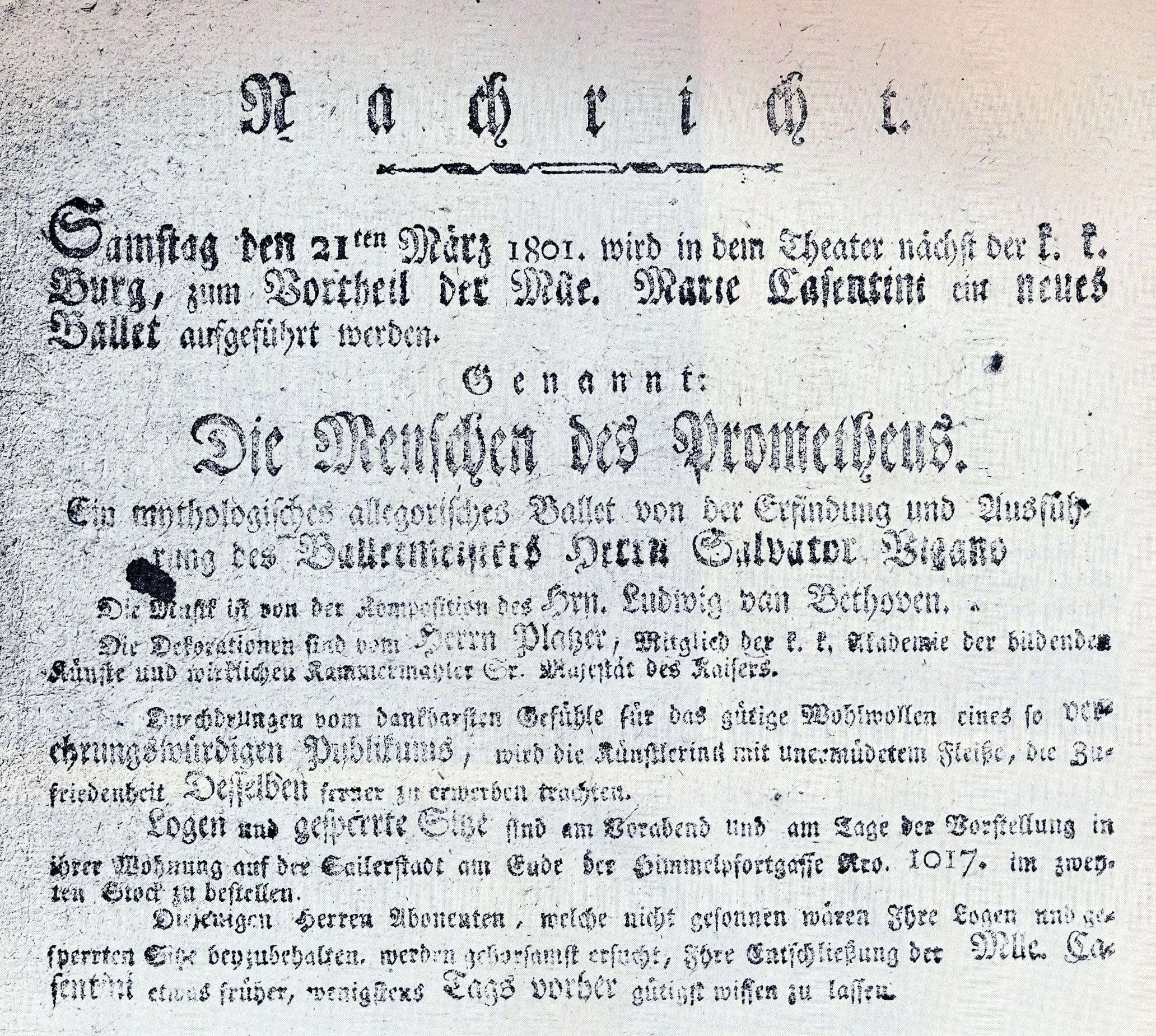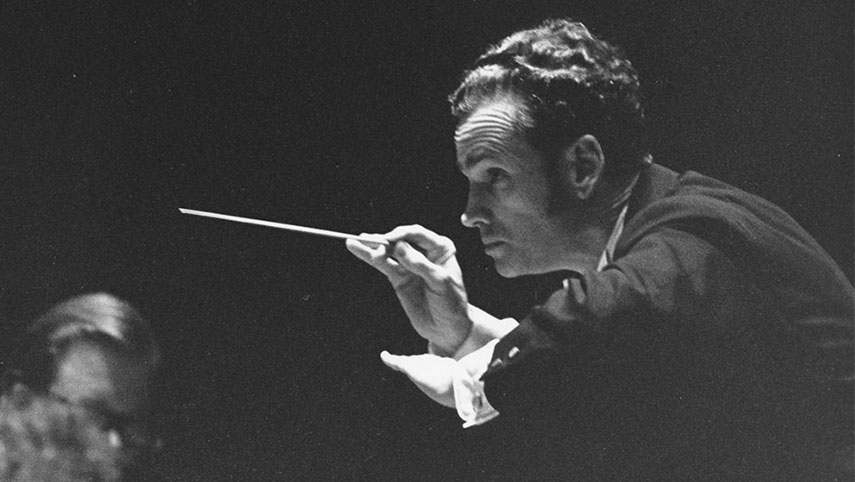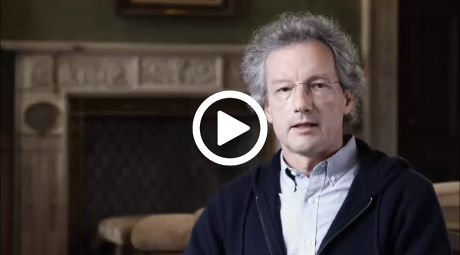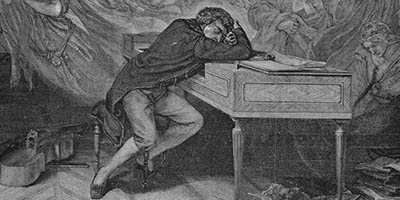Prometheus’s Prelude
Beethoven: Overture to The Creatures of Prometheus (1801)
Perhaps the most overt example of Beethoven’s interaction with the idea of Prometheus was his only published ballet, The Creatures of Prometheus. This ballet was the fruit of a collaboration between him and Salvatore Viganò, Vienna court ballet master and fellow artistic progressive. Viganò’s adaption of the Prometheus myth for Beethoven’s ballet was based on a French Enlightenment-era retelling that cast Prometheus as both the creator of humanity and its guide in becoming truly human through the power of the performing arts.
 Prometheus Creating Man in Clay (c. 1845), painting by Constantin Hansen. Prometheus Creating Man in Clay (c. 1845), painting by Constantin Hansen.
|
 Handbill for the premiere performance of The Creatures of Prometheus (March 28, 1801). Handbill for the premiere performance of The Creatures of Prometheus (March 28, 1801).
|
The connection between Prometheus and Beethoven’s overture to The Creatures of Prometheus is not programmatic, but is instead abstract and philosophical. Two aspects of the overture, as highlighted by musicologist Paul Bertagnolli, contribute to this interpretation. The first is found in the overture’s opening chords, as can be heard in this audio clip. Beethoven violates orthodox harmonic practice by starting the overture with a sequence of chords that harmonize a different key than the rest of the overture. This “transgression” against the old musical order mirrors that of Prometheus against the gods. The second is the energetic theme that Beethoven introduces in the faster allegro section. This theme prefigures the main theme used for joyful conclusion of the ballet, in which the “creatures of Prometheus” have attained true “animation through the power of the arts.”1 These two features, as well as the overture’s high spirits, help connect the overture to the ballet’s uplifting Promethean ideal.
Beethoven: Overture to The Creatures of Prometheus
The Cleveland Orchestra, Louis Lane
Archival Recording: Severance Hall, June 28, 1966
 Louis Lane (1923-2016) first joined The Cleveland Orchestra as apprentice conductor in 1947. From 1947 to 1973, he was a strong supporting presence in the Orchestra as well as northern Ohio’s musical scene. This archival recording, from when he was associate conductor, is taken from a fundraising concert held by the Orchestra in support of the Mount Sinai Hospital. The Mount Sinai Hospital, located in Cleveland’s east side, was founded in 1903 and provided healthcare to the area’s underserved population, as well as serving as a center for medical advancement and education. Photograph by Peter Hastings, Date Unknown. Courtesy of The Cleveland Orchestra Archives.
Louis Lane (1923-2016) first joined The Cleveland Orchestra as apprentice conductor in 1947. From 1947 to 1973, he was a strong supporting presence in the Orchestra as well as northern Ohio’s musical scene. This archival recording, from when he was associate conductor, is taken from a fundraising concert held by the Orchestra in support of the Mount Sinai Hospital. The Mount Sinai Hospital, located in Cleveland’s east side, was founded in 1903 and provided healthcare to the area’s underserved population, as well as serving as a center for medical advancement and education. Photograph by Peter Hastings, Date Unknown. Courtesy of The Cleveland Orchestra Archives.
 This archival recording was taken from “Violins of Hope,” a special concert on September 27, 2015 by The Cleveland Orchestra that marked the opening of the Maltz Performing Arts Center. Central to the event were the titular violins: violins played by Jews in the concentration camps, now restored and able to freely sing. Photograph by Roger Mastroianni, 2015. Courtesy of The Cleveland Orchestra Archives.
This archival recording was taken from “Violins of Hope,” a special concert on September 27, 2015 by The Cleveland Orchestra that marked the opening of the Maltz Performing Arts Center. Central to the event were the titular violins: violins played by Jews in the concentration camps, now restored and able to freely sing. Photograph by Roger Mastroianni, 2015. Courtesy of The Cleveland Orchestra Archives.
1 Paul Bertagnolli, Prometheus in Music: Representations of the Myth in the Romantic Era (New York: Routledge, 2007, 2016), 36-38.
Alexander Lawler
Alexander Lawler is a Historical Musicology PhD student at Case Western Reserve University. This is his third year working in the Orchestra’s Archives, having previously written “From the Archives” online essays (2015-2016) and designed a photo digitization and metadata project (2016-2017).

The Prometheus Project
As part of the Centennial Season’s celebration, Franz Welser-Möst has created “The Prometheus Festival,” examining Beethoven’s music through the metaphor of Prometheus.
Read more >

Overture to The Creatures of Prometheus
Perhaps the most overt example of Beethoven’s interaction with the idea of Prometheus was his only published ballet, The Creatures of Prometheus.
Read more >

Symphony No. 1
In the mainstream history of Beethoven, his early works are more classical in style, hewing close to Mozart and (especially) Haydn.
Read more >

Symphony No. 3
Beethoven’s Third Symphony, the Eroica, or “Heroic,” is one of the most influential pieces of music in history.
Read more >

Egmont Overture
Beethoven’s Egmont Overture is one of his many concert overtures depicting different kinds of heroic individuals.
Read more >

Symphony No. 4
Beethoven’s Fourth Symphony seems an anomaly compared to the heroic Third and the fateful Fifth.
Read more >

Symphony No. 7
In the Seventh, Beethoven suffuses each movement with a unique and persistent rhythmic pattern.
Read more >

Overture to Coriolan
Beethoven’s Overture to Coriolan is the only tragic piece in our Prometheus Festival. Indeed, in spite of the intense conflict that marks much of his music, Beethoven was something of an optimist
Read more >

Symphony No. 5
Beethoven’s Fifth Symphony is so familiar to us now that it might be difficult to imagine it as shocking or difficult.
Read more >

Symphony No. 8
The Eighth Symphony generally has been regarded as the slightest of Beethoven’s mature symphonies because of its short length, lighter tone, and frequent return to the musical styles and forms of the eighteenth century.
Read more >

Leonora Overture No. 3
Fidelio (1805), Beethoven’s only opera, is a celebration of freedom. In the opera, Florestan has been imprisoned by the tyrant Don Pizarro.
Read more >

Symphony No. 2
Beethoven first realized he was becoming deaf in the summer of 1798, at age twenty-seven. After an initial episode of total deafness, Beethoven found that his hearing had become filled with an unending “maddening chorus of squealing, buzzing, and humming.”
Read more >

Symphony No. 6
Beethoven’s Pastoral Symphony premiered on the same concert as the Fifth Symphony (December 22, 1808). The two works were quite different: Whereas the Fifth was a difficult journey from darkness to light, the Pastoral was a genial, warm-hearted journey through the countryside.
Read more >

Grosse Fuge
The Grosse Fuge (Great Fugue) is Beethoven’s most complex work. It was originally to be the last movement of his String Quartet No. 13. However, it unluckily proved to be both technically challenging for the performers and bewildering to the audience, and was, instead, turned into its own stand-alone work.
Read more >

Symphony No. 9
Beethoven’s Ninth Symphony stands as the culmination of Beethoven’s twenty-four-year career as a composer of symphonies. The Ninth both sums up Beethoven’s artistic career and, with the choral finale, daringly points the way forward to new conceptions of what a symphony could say and be.
Read more >